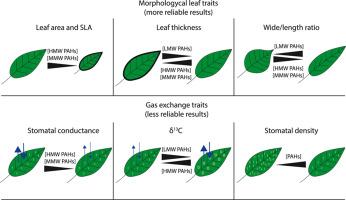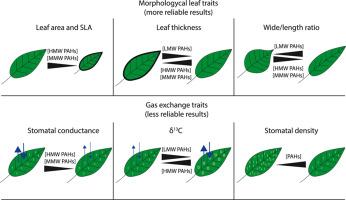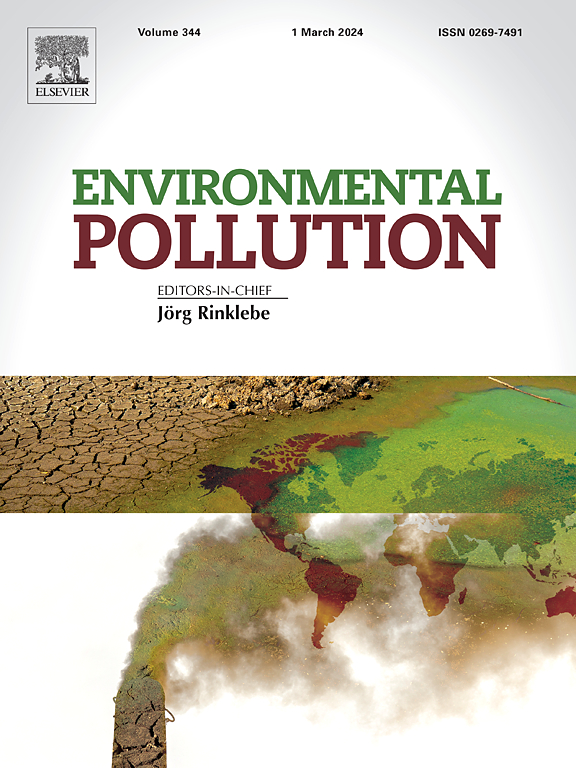灌木和乔木的叶片生态特征(形态和气体交换)与多环芳烃浓度:荟萃分析法
IF 7.6
2区 环境科学与生态学
Q1 ENVIRONMENTAL SCIENCES
引用次数: 0
摘要
乔木和灌木的叶子可以捕获大气污染物,如多环芳烃(PAHs),其吸收能力取决于叶子的特征。尽管已有大量研究测量了木本植物叶片中的多环芳烃浓度以及叶片特征的变化,但很少有研究调查了这些因素之间的关系。我们进行了一次文献综述,总结了有关这一主题的现有信息,发现有五种类型的叶片性状被研究过,其中与叶片形态和气体交换有关的性状最为常见。然而,研究结果往往相互矛盾。为了解决这些差异,我们进行了一项荟萃分析,研究与形态(叶面积、比叶面积 [SLA]、叶片厚度和叶片宽/长比 [W/L])和气体交换(气孔导度、叶片碳同位素特征 [δ13C]和气孔密度)相关的叶片生态学特征如何影响木本物种对 PAH 的吸收。荟萃分析包括涉及至少两个不同物种、具有可比多环芳烃浓度的研究。许多研究并没有考察生态性状与多环芳烃浓度之间的关系,而那些考察了生态性状与多环芳烃浓度之间关系的研究往往涉及不同的性状。因此,我们使用 TRY 植物性状数据库数据作为性状数据的标准来源。通过确定 PAHs 与性状之间的差异并计算 Spearman 相关性及其显著性来分析两者之间的关系。与气体交换性状相比,叶片形态性状与多环芳烃浓度的相关性更为密切。因此,SLA 和叶面积等形态特征可以被认为是预测多环芳烃吸收量的重要指标,尤其是颗粒相关多环芳烃。气体交换性状的相关性不太一致,这表明影响叶片吸收 PAH 的因素很复杂。这项研究强调了考虑多种叶片特征以更好地了解和预测木本植物吸收 PAH 的重要性。本文章由计算机程序翻译,如有差异,请以英文原文为准。


Leaf ecological traits (morphology and gas exchange) and polycyclic aromatic hydrocarbons concentrations in shrubs and trees: A meta-analysis approach
The leaves of trees and shrubs can capture atmospheric pollutants such as polycyclic aromatic hydrocarbons (PAHs), and the capacity of uptake depends on the leaf traits. Although numerous studies have measured PAH concentrations in leaves of woody plants and the variability in leaf traits, few have investigated the relationship between these factors. We conducted a literature review to summarize the available information on this topic and found that five types of leaf traits have been studied, with those associated with leaf morphology and gas exchange being the most common. However, the results of the studies are often contradictory. To address these discrepancies, we conducted a meta-analysis to examine how PAH uptake by woody species is affected by leaf ecological traits associated with morphology (leaf area, specific leaf area [SLA], leaf thickness and leaf width/length ratio [W/L]) and with gas exchange (stomatal conductance, leaf carbon isotopic signature [δ13C] and stomatal density). The meta-analysis included studies involving at least two different species with comparable PAH concentrations. Many of the studies did not examine the relationship between ecological traits and PAH concentration, and those that did often involve different traits. We therefore used the TRY Plant Trait Database data as the standard source of trait data. Relationships were analyzed by determining differences regarding PAHs and traits and calculating Spearman correlations and their significance. The leaf morphology traits were more closely correlated with PAH concentrations than the gas exchange traits. Thus, morphological traits such as SLA and leaf area can be considered significant predictors of PAH uptake, especially for particulate-associated PAHs. Gas exchange traits showed less consistent correlations, indicating the complexity of factors influencing PAH uptake in leaves. This study highlights the importance of considering multiple leaf traits in order to better understand and predict PAH uptake in woody plants.
求助全文
通过发布文献求助,成功后即可免费获取论文全文。
去求助
来源期刊

Environmental Pollution
环境科学-环境科学
CiteScore
16.00
自引率
6.70%
发文量
2082
审稿时长
2.9 months
期刊介绍:
Environmental Pollution is an international peer-reviewed journal that publishes high-quality research papers and review articles covering all aspects of environmental pollution and its impacts on ecosystems and human health.
Subject areas include, but are not limited to:
• Sources and occurrences of pollutants that are clearly defined and measured in environmental compartments, food and food-related items, and human bodies;
• Interlinks between contaminant exposure and biological, ecological, and human health effects, including those of climate change;
• Contaminants of emerging concerns (including but not limited to antibiotic resistant microorganisms or genes, microplastics/nanoplastics, electronic wastes, light, and noise) and/or their biological, ecological, or human health effects;
• Laboratory and field studies on the remediation/mitigation of environmental pollution via new techniques and with clear links to biological, ecological, or human health effects;
• Modeling of pollution processes, patterns, or trends that is of clear environmental and/or human health interest;
• New techniques that measure and examine environmental occurrences, transport, behavior, and effects of pollutants within the environment or the laboratory, provided that they can be clearly used to address problems within regional or global environmental compartments.
 求助内容:
求助内容: 应助结果提醒方式:
应助结果提醒方式:


